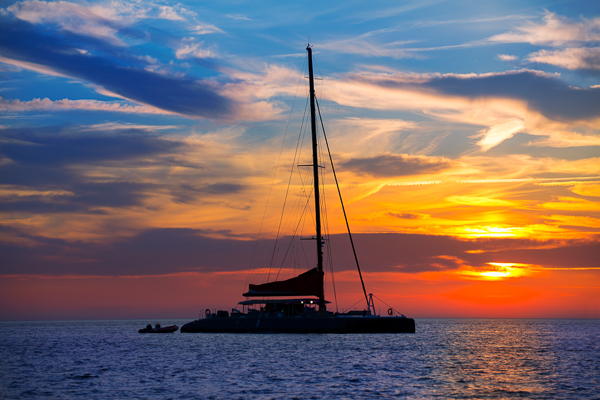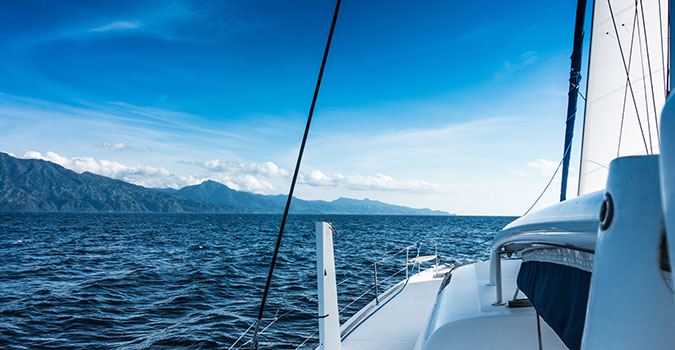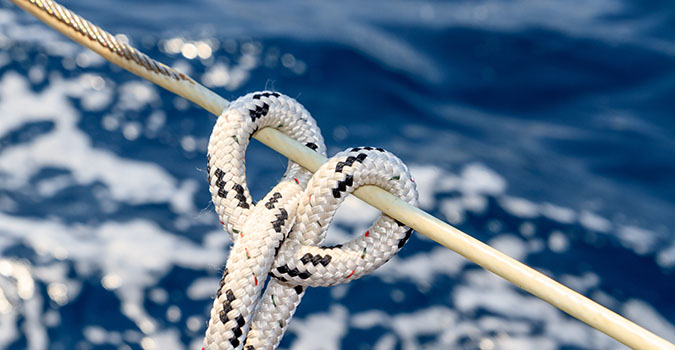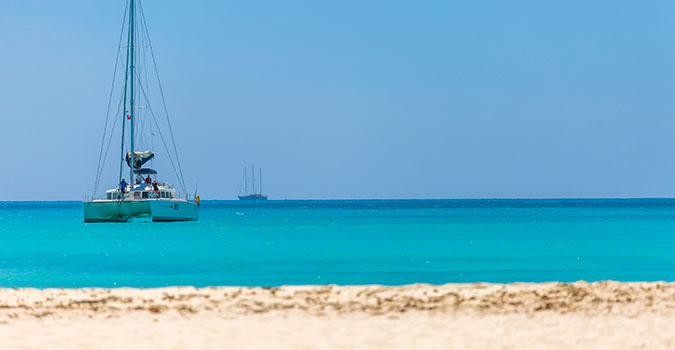Story by Phillip Berman / June 20, 2017


By now most monohull sailors have chartered a catamaran in the Caribbean or the Mediterranean and have come to appreciate the many virtues cats have to offer for cruising, including stable sailing with fewer seasick guests, faster off wind speeds, little or no rocking at anchor, a large aft cockpit for lounging and dining, privacy for each guest in suites that are far apart, and galley up cooking in a saloon bathed with light. Yet these traditional monohull sailors, while appreciative of the catamaran’s strengths, also come back from their charter experience with the same legitimate complaint-these boats sure don’t point very well and off-the-wind they steer like trucks.
For those converting from a power yacht to a sailing catamaran (and there are many these days) pointing ability and helm feel don’t mean too much. They order their catamaran with large engines and just toss in the towel when the wind is on the nose. But for those who intend on serious blue water passage making where beating for days on end is inevitable, or for those who are simply passionate about sailing, this lack of upwind performance and steering stiffness is downright aggravating.
For the most part, there are only four things you can do to greatly improve the upwind performance of cats beyond making them super light, lean and long:
It is very costly, of course, to take all of the above four steps to improve upwind performance in a cruising cat. In my view, however, you get the most mileage for your money with a super set of high tech sails and daggerboards. Of course, if you are a true sailing enthusiast or racer, taking all four steps will create a true rocket ship. When it comes to sails, much has been written already, so I’ll let the sailmakers weigh in on this one-which fabrics to use, what type of battens and what sort of cut for optimum upwind performance. Here I’ll focus simply on the pros and cons of daggerboards versus fixed keels for cruising sailors, because there are many misconceptions in the catamaran market on this subject.
A daggerboarded cat will sail consistently higher into the wind and make far less leeway than a cat with fixed keels-typically between five to seven degrees higher. This added pointing ability and reduced leeway represents a significant safety feature when cruising because it enables you to claw off a lee shore or to arrive at an upwind destination with far greater alacrity. As any blue water voyager knows, sometimes you cannot “run for cover”-you must “beat for cover.” A daggerboarded cat, all things being equal, will sail at least 1 to 2 knots faster, on average, than a catamaran with keels simply because it isn’t carrying the enormous fixed hydrodynamic drag (i.e. wetted surface) of two long and deep fixed keels. This added speed is a significant safety feature for longrange cruising. Not only are long passages cut shorter, reducing exposure to adverse weather, but should one encounter adverse weather it is much easier to either run from it or avoid it entirely with proper weather routing. A faster boat always increases one’s options, and therefore increases safety, when cruising. A daggerboarded cat typically draws one to two and a half feet less water than a cat with keels. As such, the sailing grounds and potential anchorages available to a cat with daggerboards are considerably larger than those available to a keel cat. In extremely severe seas daggerboards enable the skipper to adjust the balance of his catamaran by raising and lowering the boards.
When sailing in large cross-seas you typically raise the leeward daggerboard entirely and lower the windward board halfway to prevent being tripped over by a breaking wave. A keel cat is stuck with the keels down, all the time-as such, there is no way to prevent the boat from “tripping over herself ” in storm-force conditions with large breaking cross seas.
Off the wind a catamaran with fully raised daggerboards is much faster because wetted surface has been greatly reduced. But, more significantly, the maneuverability of a cat with raised boards off the wind is astounding. For the true sailing enthusiast there is nothing like surfing downwind on a daggerboarded cat-the boat feels loose and free with fully raised boards. The keeled cat, on the other hand, is always to an extent sailing down a train track it cannot escape.

Daggerboards are very costly to construct. A builder must create dual daggerboards as well as dual daggerboard trunks, along with the winches and pulley system to raise and lower them. Dual daggerboards add about $30,000 to $50,000 to the construction cost of a 45-foot catamaran. So you will always pay more to get a cat with daggerboards.
Daggerboarded cats are less ideal for bareboat chartering because bareboat sailors run aground a lot. Even if they are told to raise the daggerboards when they are not beating, after a few “Painkillers” they forget, which results in broken daggerboards. Charter sailors tend not to care about performance, so there is no sense offering them a costly option they will likely break.
Daggerboards that are not carefully installed by a professional shipyard can rattle in their trunks. This is annoying. A well-built cat will not have this problem.
If you are not a careful navigator and operate near shallow waters with one of your daggerboards in the down position and plow into a hard reef at high speed, you will break it. The good news is that you simply raise the broken board and sail away. The bad news is that a new board will cost about $8,000 to replace. To put this in perspective, if you had a hard grounding on a keel cat you would have to haul the boat and have the keel repaired at a shipyard. To replace a daggerboard you do not have to haul the boat or rely on a shipyard to do fiberglass repair. All this said, it is likely a few thousand dollars cheaper to repair a fixed keel (they are largely speaking just large chunks of glass and resin) than a costly vacuum bagged foam composite daggerboard.
If you are sailing far offshore and run into something with the boards down, chances are you will break just one board. It is easy enough to sail with one broken daggerboard as you can lower the unbroken boardif you must sail upwind. (A single daggerboarded cat will still far outpoint a keeled cat.) Daggerboard trunks take away a modest amount of interior room from the inside of each hull.

Daggerboards are for racers only. Not so. I am convinced this myth is propagated by builders who do not offer daggerboards due to their cost.
Daggerboards are complex to operate. Not so. Unless you are sailing upwind they are always in the raised position. When you sail upwind you simply un-cleat the boards and let them drop. To raise them you simply pull a few turns on a winch. It is easy to operate daggerboards.
You cannot beach a daggerboarded cat. No so. A properly built daggerboarded cat is easily beached and indeed can beach much closer to shore. The entire bottom of a well-built daggerboarded cat is solid fiberglass.
Since high volume production catamaran builders must sell nearly 50 percent of their yachts into bareboat charter, it is not surprising that none of their models have daggerboards. At the present time there are just four production builders of daggerboarded cats: Catana, Outremer, Gunboat and Dolphin. There are of course a wide range of custom and semi-custom dagger-boarded cats on the market, particularly in New Zealand and Australia.
I confess that my own background is that of a racer. Sailing is a kind of grace, a kind of magic to me, and therefore I prefer to own and sail daggerboarded cats-I love to pump upwind as high as a monohull but even faster, and I find surfing a cat in big seas with the daggerboards up is truly exciting. Yet over the years I have sold hundreds of fixed-keel catamarans and they work perfectly well for the needs of the bulk of the buyers I have advised. Most sailors I have learned are far less concerned with the performance of their cats underway than they are with her comfort at anchor. Indeed, they should be- the bulk of those who voyage in the Caribbean and Bahamas really spend 95 percent of their time on the hook. There is not a lot of sense in them purchasing a more costly daggerboarded cat unless they are true blue water voyagers or simply love to sail and expect their boat to return the love.
Awesome company that worked as my brokerage on purchasing out FP catamaran. A special shoutout to Will Miller for walking us through the process
The process of selling our boat was made very smooth by the Multihull Company and Andrew Hodgdon in particular. Andrew helped us navigate the selling process including moving our boat from Grenada to Florida to execute the sale. We would recommend working with this company, and Andrew Hodgdon in particular, without hesitation.
Very smooth process. Chuck was great and very knowledgeable about the whole process. Im happy to have had TMC to take care of all the things i didnt know about.
Andy
We feel like we got tremendous service from Chuck. He is a total professional, knowledgeable, confident and a natural salesman. While I’m really sad to give up the boat, we are compl we are completely satisfied that Chuck sold it for us.
The Multihull Company-St Augustine, and in particular Andrew Hodgdon handled the sale of my Balance 442 Catamaran. Andrew was professional, transparent and a pleasure to do business with.
Successful relationships cannot exist without it. At The Multihull Company we base every relationship on a firm commitment to earning and retaining our client’s trust.
Advice of any kind is valuable only when grounded in hard-won expertise. It too, must be trustworthy. Trust and expertise define the heart and soul of The Multihull Company. We are a team of skilled professionals who thrive on providing expert, trustworthy advice and service to catamaran and trimaran sailors around the globe.
Read More